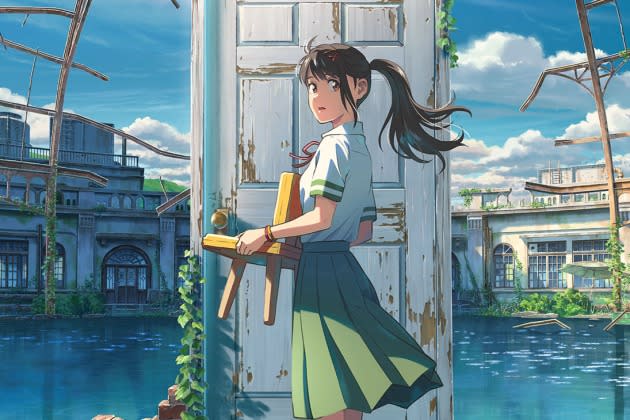‘Suzume’ Review: Anime Maestro Makoto Shinkai Returns With a Coming-of-Age Adventure That Pulses With Feeling
- Oops!Something went wrong.Please try again later.

Although one might feel weary in advance to hear Suzume is yet another anime in which a young person is enlisted into a struggle to save their family/hometown/Japan/the world, this one’s a keeper.
A hefty hit locally in the wake of its November 2022 release — where it’s grossed over $100m — this latest feature by multi-hyphenate talent Makoto Shinkai (the force of nature behind hits Your Name and Weathering With You) offers his signature blend of fantasy, quotidian realism and idealistic young lovers. Although often funny, a deep sense of loss is baked into the bones of the film by the fact that its title character (voiced in the original Japanese version by Nanoka Hara) lost her mother in the 2011 tsunami-earthquake that killed nearly 20,000 people and caused the Fukushima nuclear power plant disaster.
More from The Hollywood Reporter
Berlin: Disney+ Mafia Drama 'The Good Mothers' Wins Inaugural Berlinale Series Award
'Bad Living' ('Mal Viver') Review: A Miserable Melodrama of Female Cruelty
Not unlike the way Weathering With You sought to link the climate crisis with magical thinking, Suzume finds its heroine accidentally opening a portal that lets in destructive beings from another world who cause earthquakes. She must reverse the damage before Tokyo is destroyed, helped by a children’s chair brought to life that contains the enchanted spirit of a potential boyfriend (long story), and contend with a super-cute but fiercely independent cat who doesn’t care about saving the nation if it means he can’t have fun and fishy treats. (Clearly this is the work of someone who understands cats.) Bowing internationally in the 2023 Berlinale’s main competition, Suzume, like its heroine, has a long journey ahead as it rolls out across worldwide territories.
After a pre-title cold open where a distraught young Suzume, searching for her missing mother, is helped in 2011 by a kind but barely-seen young woman, the film shifts to the present time. In Kyushu, a large island in southwestern Japan, Suzume Iwato, now a high-school junior, lives with her aunt Tamaki (Eri Fukatsu). Loving and a bit overprotective, Tamaki secretly feels, we later learn, as if she’s sacrificed her own love life to look after Suzume since her sister, Suzume’s mother, died. On her way to school one day, Suzume meets Souta (Hokuto Matsumura), a handsome young man with bad-boy long hair who mysteriously says he is looking for a door.
Suzume goes to look for him at an abandoned bathhouse complex outside of town, where she sees a door freestanding in the middle of a puddle. She pulls up a stone statue from the ground nearby that turns into a white cat that runs away. When she opens the door, Suzume can see beyond, but not enter, a crepuscular world of wind-ruffled fields and star-filled lilac skies, which she later learns is called the Ever After, where all time exists in a perpetual now (or something like that).
Either way, it turns out that, in the tradition of all great folk and fairy tales, Suzume learns that what seemed like perfectly reasonable acts of curiosity on her part may have devastating consequences. For instance, the stone-statue-turned-cat, who sets off on a wander all over Japan and picks up the name Daijin from social media users who keep filming and photographing him, was actually a “keystone” that sealed off the Ever After from our world. By setting Daijin free, Suzume has also released the Worm, a giant smoke-like, semi phallic, gargantuan entity that sprouts out of the door, rises into the air and, if not stopped, will cause an earthquake when it lands. Ordinary people can’t see it, but Suzume can now. So can Souta, who is soon turned into a wooden chair that’s missing a leg that Suzume’s late mother made for her years ago by naughty Daijin.
All that sets up a picaresque adventure for Suzume and Souta as they travel across Japan via boats, trains and automobiles in pursuit of Daijin, stopping along the way to close further doors in abandoned places — amusement parks, subway stations — that release the Worm into the sky. All of this gives Shinkai and his team of background artists ample time to show off the production company’s flair for gritty, textural illustration, particularly of urban environments. Clearly working with photographic references, every frame and panorama is crammed with detail and clutter: litter on sidewalks, flowers that grow through concrete, thousands of animated faces-in-the-crowd scenes. The realm of the Ever After, in contrast, is harder-edged and colder in town, especially at the climax when the Worm turns into a menacing nest of spirals and coils, like blood red snakes.
But Shinkai never skimps on the human level. Suzume, who at first seems like just another standard-issue anime ingenue, grows and becomes more interesting throughout — as does Souta, who is amazingly expressive for a chair, thanks to crack object-animation skills and smart screenwriting. The teeming cast of supporting characters — from a hostess in a karaoke bar with two wild toddler twins to a colleague of Tamaki’s that has a crush on her and a hipster university friend of Souta’s who offers the team a ride toward the end — are drawn with vivid strokes in every sense.
It becomes clear that this abundance of vitality is there not just for comic relief and world-building but to remind us of all the people who could be lost in a catastrophe like the earthquake of 2011. The stakes here are not just the growing attraction between Suzume and Souta, but a vastly larger community formed by intricate bonds of familial, fraternal and romantic feeling.

